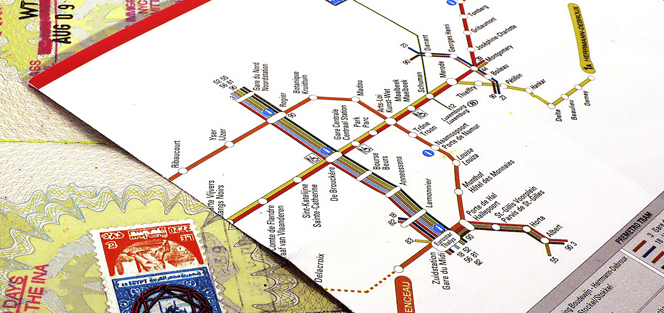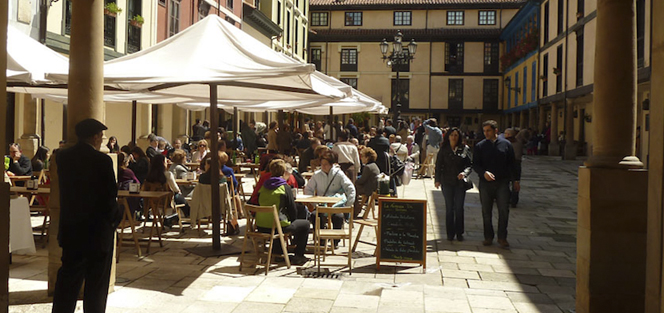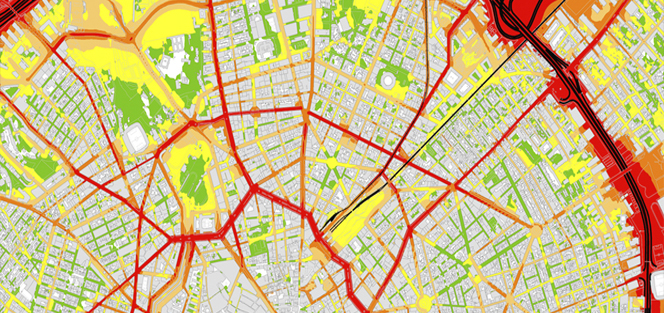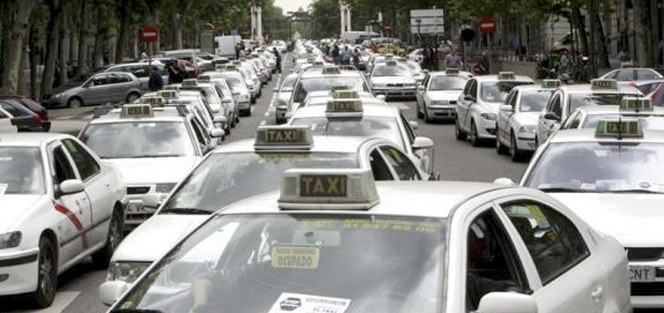Strategic noise maps
In the fight against noise pollution, it is often difficult to take actions that can have positive effects in the short term, given that governments must combine acoustic criteria along with many others (industry, transport and mobility, jobs creation, economic growth, leisure …). Therefore, it is necessary to adopt strategic policies that will involve different actors in this fight, so that noise is no more considered as a minor issue, and it is weighted with the same importance as other socioeconomic and environmental factors.
Strategic actions have proven to be highly effective in protecting the environment (for example, in reducing emissions in vehicles, or in the gradual reduction of the noise produced by aircraft). In the case of noise, the goal is to create a trend that reduces ambient noise levels in the long term, which should involve different fields of science and engineering, as well as the policy makers (from local governments, and the European authorities). In this long-term goal, the noise maps play a crucial role, as they are a diagnosis tool that allows to alert competent authorities to inform the citizenship and to raise awareness on this problem.
A noise map is a graphical representation of the existing noise level in an area. In addition to diagnosis, this tool allows to evaluate a priori the effectiveness of mitigation measures, in the short or long term, and to estimate the number of people exposed to noise. Noise maps are extremely useful in urban planning, defining land uses and noise sensitive areas, as well as for the assessment of noise impact to produce an activity or infrastructure, even before its implantation.
Urban noise
Noise pollution is a major environmental problems unsolved in cities, affecting a large percentage of residents who have their welfare, their rest or their quality of life reduced because of the noise pollution.
The strategic noise maps and conventional noise monitoring networks are tools that have traditionally been used only to diagnose the problem of noise pollution (the first step, which often becomes the only step). But, unlike other pollutants, some of the effects caused by people such as annoyance or stress, have a strong subjective component that the noise maps and traditional monitoring networks cannot collect.
Airports, and some cities, routinely use noise monitors to measure the acoustic emissions, and to publish these data. However, people affected by noise often expressed distrust about the values published or discrepancy with the indicators used, or, in most cases, a complete ignorance regarding the information provided. This is due to the erroneous conception of awareness strategies and unidirectional communication in which citizens (and other agents) are mere observers.
One of the main research lines of the I2A2 Group seeks to explore alternative and complementary pathways to solve the noise problem, focusing on the subjective components, and the interaction with the citizen. Beyond measures to diagnose the problem, a new approach is proposed to further reduce the effects of noise causes, thanks to advances in digital society and the development of smart cities.
This new approach is based on Policy Making 3.0, a model of participatory management supported by evidence, whereby managers and stakeholders interact, based on scientific evidence as well as the feelings and aspirations of the parties concerned.
The goal is not only to deploy tools to adequately characterize the noise sources, but getting citizens’ involvement, and to achieve an interaction that allows to raise awareness in society at all levels. For this aim, it is particularly necessary to ensure interaction with people more exposed to noise, such as residents in a leisure area.
Soundscapes
Cada sociedad particular condiciona la producción de sus propios sonidos y la forma de percibirlos. Esto permite considerar el sonido como uno de los factores que definen el sentido “de lugar” o “no lugar” de un determinado espacio urbano. Para Marc Auge, un lugar puede definirse como lugar de identidad, relacional e histórico; por el contrario un espacio que no pueda definirse ni como espacio de identidad ni como relacional ni como histórico, es considerado un no lugar. Auge considera que la “sobremodernidad” es productora de no lugares, de espacios que no son en sí lugares antropológicos, es decir espacios diseñados y desarrollados por y para el hombre de una determinada sociedad. Evidentemente los sonidos y su capacidad evocativa y caracterizadora del ambiente no pueden ser dejados de lado en la construcción y recuperación de los lugares antropológicos. Esta cultura urbana es
particular y propia de cada sociedad. Los espacios públicos, con su paisaje sonoro, forman parte de la construcción de la identidad urbana de una ciudad.
The soundscape approach shifts the problem of studying the acoustic environment from the indoor residential areas, focused on the noise effects, to open urban outdoor areas, studied from the ability of sound to give identity and quality to a space.
The concept of soundscape was proposed by Raymond Murray Schafer in 1969 under the principle that the sound should be considered as a means of communication between man and the urban environment. The concept coined by Schafer is expressed as the concrete soundscape of a given real place, and that is inherently local and specific to each location. Schafer’s terminology helps to express the idea that the sound of a particular location can express the identity of a community so that settlements can be differentiated by their soundscape.
Each particular society determines the production of its own sounds and the way they are perceived.
Smart cities
Beyond noise, the sound of a city entails information that can be used in various fields. Clearly related to the growth of ICT and sensor networks in the Smart Cities of the Future, the development of advanced instrumentation will allow to extract this information and enabling exploitation possibilities for different city’s services.
Some of the possibilities open to the development and research in this field are:
- Recognition and classification of sounds. You can allow detection of emergency vehicle sirens or alarms, detect rellertas, or situations of traffic congestion, vehicle detection in a row …
- Localization of sound sources. Detecting the origin of a sound can afford can be useful in certain applications related to security.
In the fight against noise pollution, it is often difficult to take actions that can have positive effects in the short term, given that governments must combine acoustic criteria along with many others (industry, transport and mobility, jobs creation, economic growth, leisure …). Therefore, it is necessary to adopt strategic policies that will involve different actors in this fight, so that noise is no more considered as a minor issue, and it is weighted with the same importance as other socioeconomic and environmental factors.
Strategic actions have proven to be highly effective in protecting the environment (for example, in reducing emissions in vehicles, or in the gradual reduction of the noise produced by aircraft). In the case of noise, the goal is to create a trend that reduces ambient noise levels in the long term, which should involve different fields of science and engineering, as well as the policy makers (from local governments, and the European authorities). In this long-term goal, the noise maps play a crucial role, as they are a diagnosis tool that allows to alert competent authorities to inform the citizenship and to raise awareness on this problem.
A noise map is a graphical representation of the existing noise level in an area. In addition to diagnosis, this tool allows to evaluate a priori the effectiveness of mitigation measures, in the short or long term, and to estimate the number of people exposed to noise. Noise maps are extremely useful in urban planning, defining land uses and noise sensitive areas, as well as for the assessment of noise impact to produce an activity or infrastructure, even before its implantation.
Urban noise
Noise pollution is a major environmental problems unsolved in cities, affecting a large percentage of residents who have their welfare, their rest or their quality of life reduced because of the noise pollution.
The strategic noise maps and conventional noise monitoring networks are tools that have traditionally been used only to diagnose the problem of noise pollution (the first step, which often becomes the only step). But, unlike other pollutants, some of the effects caused by people such as annoyance or stress, have a strong subjective component that the noise maps and traditional monitoring networks cannot collect.
Airports, and some cities, routinely use noise monitors to measure the acoustic emissions, and to publish these data. However, people affected by noise often expressed distrust about the values published or discrepancy with the indicators used, or, in most cases, a complete ignorance regarding the information provided. This is due to the erroneous conception of awareness strategies and unidirectional communication in which citizens (and other agents) are mere observers.
One of the main research lines of the I2A2 Group seeks to explore alternative and complementary pathways to solve the noise problem, focusing on the subjective components, and the interaction with the citizen. Beyond measures to diagnose the problem, a new approach is proposed to further reduce the effects of noise causes, thanks to advances in digital society and the development of smart cities.
This new approach is based on Policy Making 3.0, a model of participatory management supported by evidence, whereby managers and stakeholders interact, based on scientific evidence as well as the feelings and aspirations of the parties concerned.
The goal is not only to deploy tools to adequately characterize the noise sources, but getting citizens’ involvement, and to achieve an interaction that allows to raise awareness in society at all levels. For this aim, it is particularly necessary to ensure interaction with people more exposed to noise, such as residents in a leisure area.
Soundscapes
Cada sociedad particular condiciona la producción de sus propios sonidos y la forma de percibirlos. Esto permite considerar el sonido como uno de los factores que definen el sentido “de lugar” o “no lugar” de un determinado espacio urbano. Para Marc Auge, un lugar puede definirse como lugar de identidad, relacional e histórico; por el contrario un espacio que no pueda definirse ni como espacio de identidad ni como relacional ni como histórico, es considerado un no lugar. Auge considera que la “sobremodernidad” es productora de no lugares, de espacios que no son en sí lugares antropológicos, es decir espacios diseñados y desarrollados por y para el hombre de una determinada sociedad. Evidentemente los sonidos y su capacidad evocativa y caracterizadora del ambiente no pueden ser dejados de lado en la construcción y recuperación de los lugares antropológicos. Esta cultura urbana es
particular y propia de cada sociedad. Los espacios públicos, con su paisaje sonoro, forman parte de la construcción de la identidad urbana de una ciudad.
The soundscape approach shifts the problem of studying the acoustic environment from the indoor residential areas, focused on the noise effects, to open urban outdoor areas, studied from the ability of sound to give identity and quality to a space.
The concept of soundscape was proposed by Raymond Murray Schafer in 1969 under the principle that the sound should be considered as a means of communication between man and the urban environment. The concept coined by Schafer is expressed as the concrete soundscape of a given real place, and that is inherently local and specific to each location. Schafer’s terminology helps to express the idea that the sound of a particular location can express the identity of a community so that settlements can be differentiated by their soundscape.
Each particular society determines the production of its own sounds and the way they are perceived.
Smart cities
Beyond noise, the sound of a city entails information that can be used in various fields. Clearly related to the growth of ICT and sensor networks in the Smart Cities of the Future, the development of advanced instrumentation will allow to extract this information and enabling exploitation possibilities for different city’s services.
Some of the possibilities open to the development and research in this field are:
- Recognition and classification of sounds. You can allow detection of emergency vehicle sirens or alarms, detect rellertas, or situations of traffic congestion, vehicle detection in a row …
- Localization of sound sources. Detecting the origin of a sound can afford can be useful in certain applications related to security.
Cada sociedad particular condiciona la producción de sus propios sonidos y la forma de percibirlos. Esto permite considerar el sonido como uno de los factores que definen el sentido “de lugar” o “no lugar” de un determinado espacio urbano. Para Marc Auge, un lugar puede definirse como lugar de identidad, relacional e histórico; por el contrario un espacio que no pueda definirse ni como espacio de identidad ni como relacional ni como histórico, es considerado un no lugar. Auge considera que la “sobremodernidad” es productora de no lugares, de espacios que no son en sí lugares antropológicos, es decir espacios diseñados y desarrollados por y para el hombre de una determinada sociedad. Evidentemente los sonidos y su capacidad evocativa y caracterizadora del ambiente no pueden ser dejados de lado en la construcción y recuperación de los lugares antropológicos. Esta cultura urbana es
particular y propia de cada sociedad. Los espacios públicos, con su paisaje sonoro, forman parte de la construcción de la identidad urbana de una ciudad.
The soundscape approach shifts the problem of studying the acoustic environment from the indoor residential areas, focused on the noise effects, to open urban outdoor areas, studied from the ability of sound to give identity and quality to a space.
The concept of soundscape was proposed by Raymond Murray Schafer in 1969 under the principle that the sound should be considered as a means of communication between man and the urban environment. The concept coined by Schafer is expressed as the concrete soundscape of a given real place, and that is inherently local and specific to each location. Schafer’s terminology helps to express the idea that the sound of a particular location can express the identity of a community so that settlements can be differentiated by their soundscape.
Each particular society determines the production of its own sounds and the way they are perceived.
Smart cities
Beyond noise, the sound of a city entails information that can be used in various fields. Clearly related to the growth of ICT and sensor networks in the Smart Cities of the Future, the development of advanced instrumentation will allow to extract this information and enabling exploitation possibilities for different city’s services.
Some of the possibilities open to the development and research in this field are:
- Recognition and classification of sounds. You can allow detection of emergency vehicle sirens or alarms, detect rellertas, or situations of traffic congestion, vehicle detection in a row …
- Localization of sound sources. Detecting the origin of a sound can afford can be useful in certain applications related to security.












